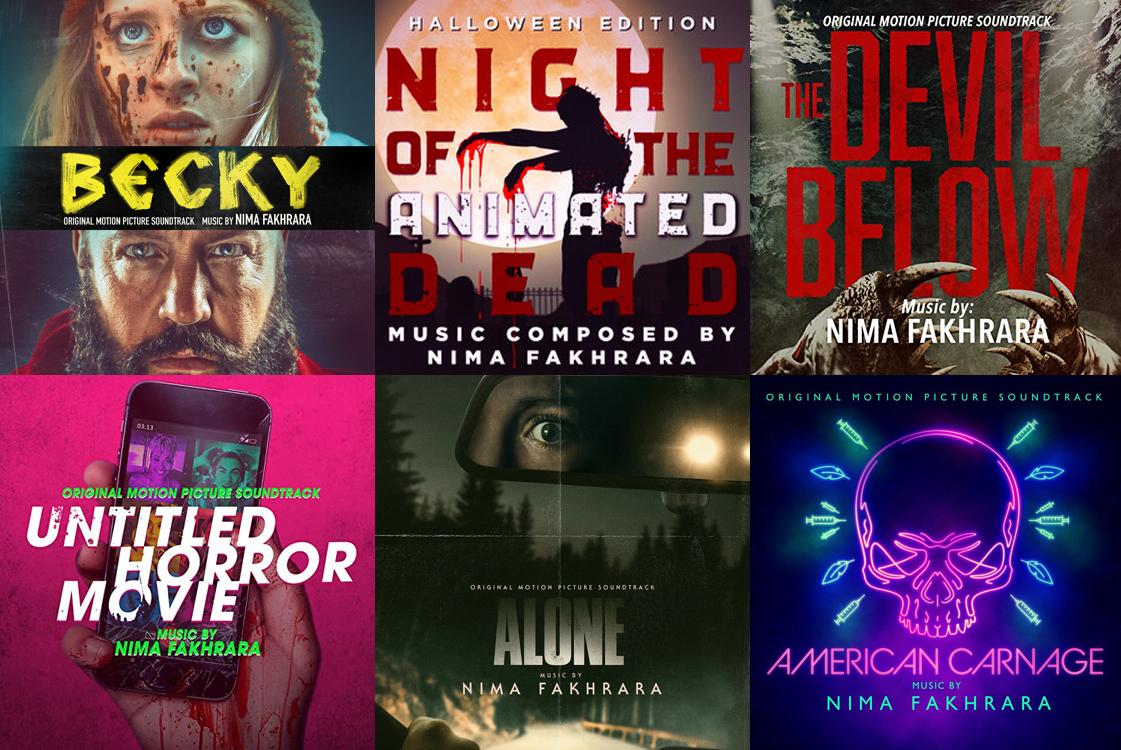September 28, 2022
Recent Horror Scores: A Chat With Composer Nima Fakhrara
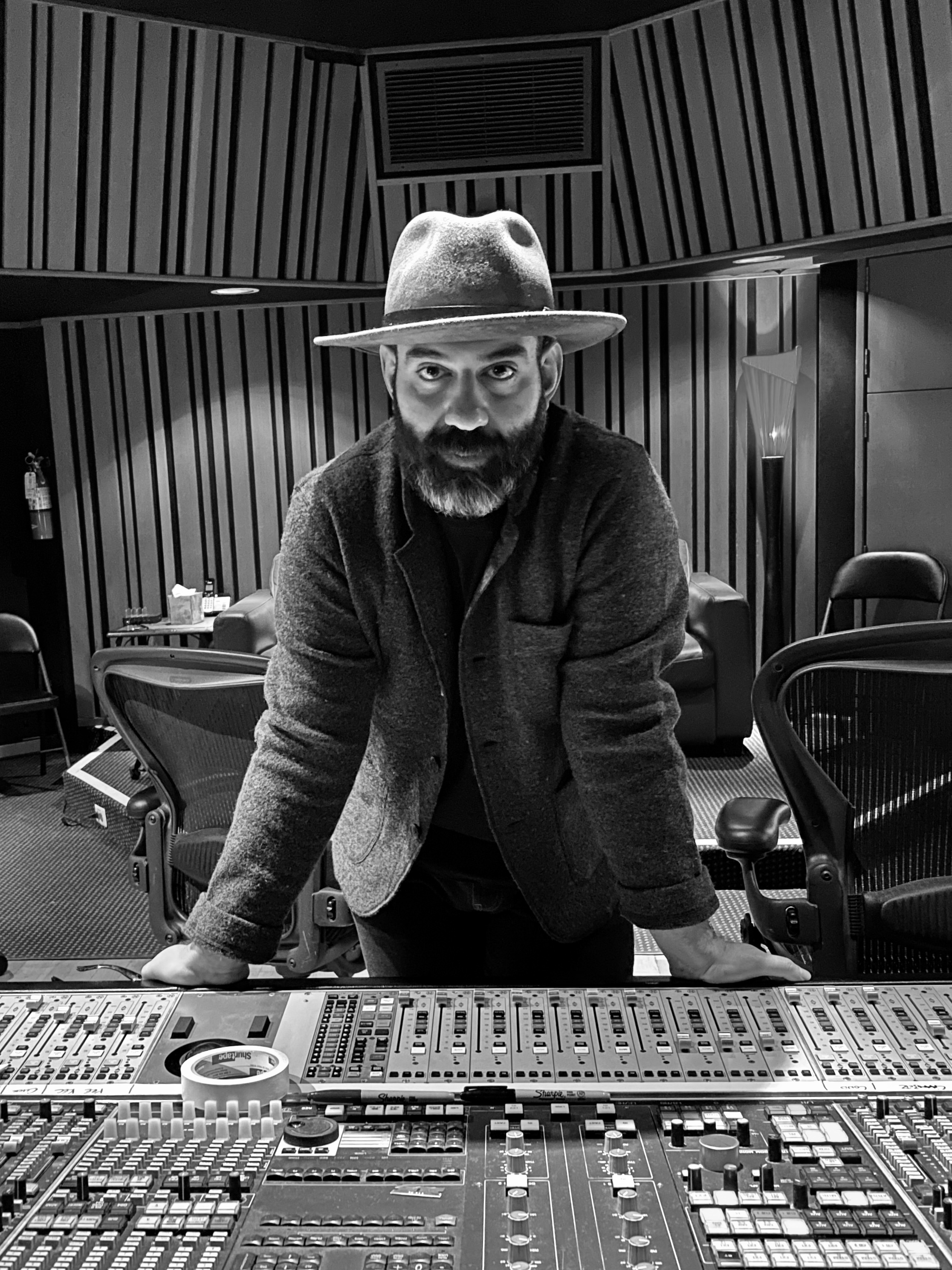
Interview by Randall D. Larson
Iranian-born composer Nima Fakhrara has honed his craft for nearly twenty years by scoring more than 100 feature films, multiple AAA game franchises and international television shows, as well as crafting commercial music for boutique brands. His unique blend of East-meets-West and command of striking, sonic textures and timbres led gaming legend David Cage to select him to compose the music for 2018’s wildly successful and critically acclaimed DETROIT BECOME HUMAN and the latest edition to the STAR WARS video game franchise, ECLIPSE. Other gaming credits include WARHAMMER: SPACE MARINES 2, RESIDENT EVIL: REVELATIONS 2 and 1979 REVOLUTION. The urgency and dark emotion of Nima’s music is well-suited for dramatic action and horror films as well, leading him to work with Golden Globe winner Hany Abu Assad and horror legend Kevin Williamson (SCREAM) on their films THE COURIER and SICK, respectively. Other notable credits: Jonathan Millott and Cary Murnion’s modern cult-classic BECKY, John Stalberg’s CRYPTO, and the final Wes Craven production, THE GIRL IN THE PHOTOGRAPHS. Nima is the founder of Zoo Creatives and The Farm with studios located in Los Angeles, New York, Connecticut, and Madrid.
I recently spoke with Nima Fakhrara about some recent horror scores he was involved in.
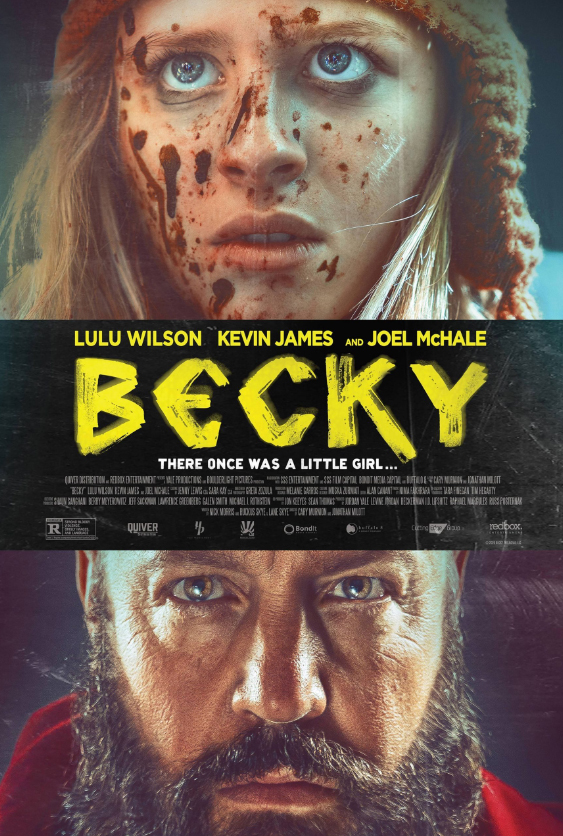
BECKY: A teenager’s weekend at a lake house with her father takes a turn for the worse when a group of convicts wreaks havoc on their lives.
Q: A fierce character-based action film you scored a couple of years ago was BECKY. What can you tell me about scoring that project?
Nima Fakhrara: The way I treated Becky was that we’re dealing with an origin story of a superhero. There were a lot of brand new melodic ideas. There are vocals in that one as well, but they are a lot more of a younger person and very much synthesized vocals. It’s pretty bad ass.
Q: How would you describe your thematic base for this score?
Nima Fakhrara: Childhood recklessness! At the time when I was scoring it, it was interesting because I just had a child, so there’s a lot of funny toy musical instruments around the house, so that was all over BECKY – funny whistles, tambourines, and such. It was a very reckless score and it needed to be that way!
(A sequel, BECKY 2: THE WRATH OF BECKY, has been announced. Lulu Wilson will return in the role of the unstoppable Becky in a sequel, and Fakhrara will score the new film).
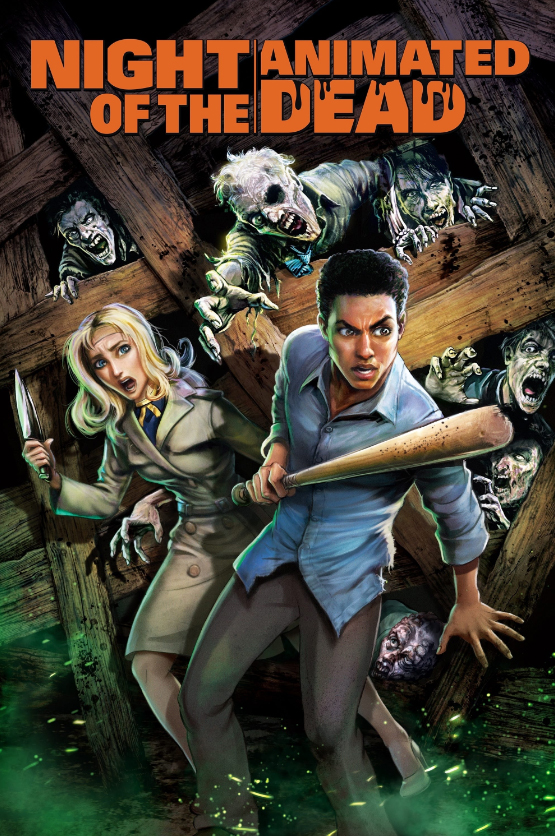
NIGHT OF THE ANIMATED DEAD: An animated version of a classic: visiting their dad’s grave in the countryside, two siblings are attacked by a zombie. Barbara escapes to a farmhouse. A man helps barricade the house as more zombies arrive outside.
Q: How did NIGHT OF THE ANIMATED DEAD come about and how would you describe its score?
Nima Fakhrara: It’s NIGHT OF THE LIVING DEAD in an animated world, pretty much shot-by-shot. I’m obviously a huge fan of horror, as you already know, with all the stuff that I do! So I took the opportunity to just try to write a score that was original – the Romero film, of course, didn’t have an original score; it was all licensed music from different movies that he had access to. So this was an opportunity to write an original score for it, and I took on the challenge of figuring it out. I treated it like it was a band setting, in a way: I cast some amazing musicians – I had a couple of sax players, I had a clarinet player, and I had a violinist who was Western classically trained, and I told her to put everything away and just do things that she’d always wanted to do but was never allowed to do! So there was a lot of back-and-fourth of material going from me to the musicians and from the musicians back to me. That’s how the score was created.
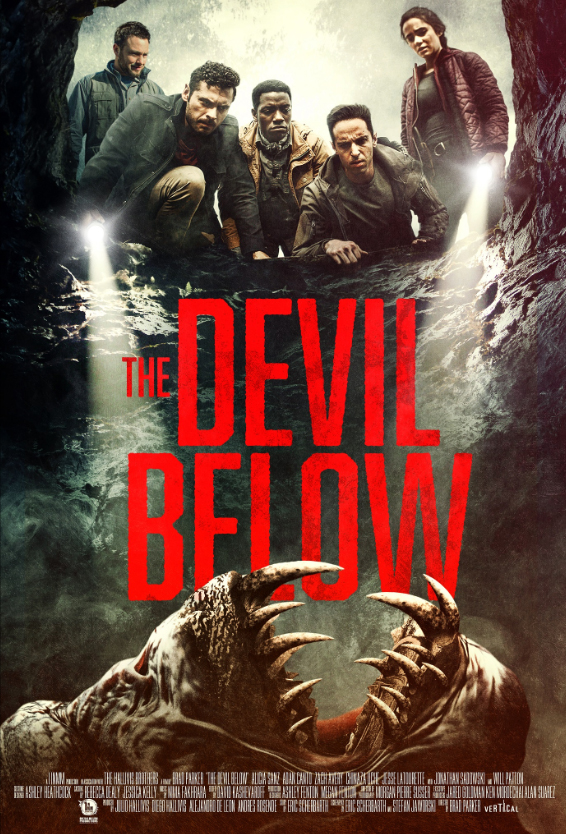
THE DEVIL BELOW: A group of four amateur adventurers who specialize in exploring remote and forsaken places pay a visit to Shookum Hills, a town in the remote Appalachian Mountains, which was abandoned decades ago due to a mysterious coal mine fire.
Q: You scored THE DEVIL BELOW in 2021, for director Bradley Parker.
Nima Fakhrara: That one was a fun one. DEVIL BELOW is a score where I go back to the idea of custom instruments – building them for this movie. Brad and I wanted to achieve this concept of hi-tension for a long period of time, but we didn’t want it to be just constant drones. I actually built an instrument for this – it’s a cylinder about five feet high and three feet wide; it’s all screwed up and down with strings that are wrapped around this whole thing, so you could walk around it and bow the strings. You can be continuously bowing this, and it doesn’t sound endlessly like a pad. You’re actually performing this and all of these strings are resonating on top of each other. That was one of the signature sounds that we got. It’s a monster movie but what’s cool about it is that we’re dealing with caves and a whole world below ground level. There were a lot of things that I did with caves – recording cave noises and bringing that sound world into the score.
Q: I understand the film takes place in the Appalachian Mountains; did that environment key in on any of your music?
Nima Fakhrara: Kind of. We’re more below the earth than we are above it, but it was about my going back to the sonic world of Harry Partch and very unique musical atmospheres. I got to explore a little bit how I could bring nature into our music.
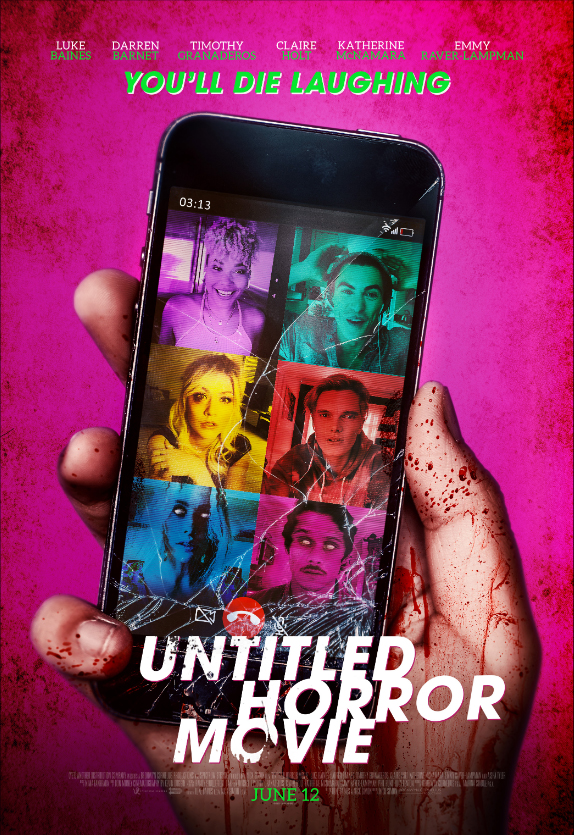
UNTITLED HORROR MOVIE: A comedy about making a horror movie. When six co-stars learn their hit TV show is about to be canceled, they decide to shoot their own film, unintentionally summoning a spirit with an affinity for violence.
Q: You scored UNTITLED HORROR MOVIE in 2021 for director Nick Simon. What can you tell me about scoring that one?
Nima Fakhrara: It’s a comedy horror film. It was the beginning of the pandemic and Nick called me up and said “I’m going to do a movie over Zoom! It’s going to be a horror movie and the actors are going to shoot it themselves and everything like that!” That was my first experience of doing something all over Zoom, and he wanted it to feel like a comedy. Nick and I have worked together many times and is one of the collaborators I have worked with the most. This one was nothing different – it was “let’s go back to the concept of how horror is made and let’s do classic horror and bring the world of technology into it.” So it’s a lot of classical horror writing with a pandemic orchestra, and it worked. It’s a pretty funny movie; it’s very much of a horror fan world. If you’re a fan of horror and comedies like Wes Craven, that’s what it is.
Q: What was your musical palette for this?
Nima Fakhrara: It was a small orchestra, very much in the Bernard Herrmann world of classic horror scores, but then I threw in the kitchen sink of synthesizers on top of it. What was tricky about it was combining the new technology that we have with that old school classical writing style, how to combine was the challenging part of it. It was pretty awesome to be able to do it.
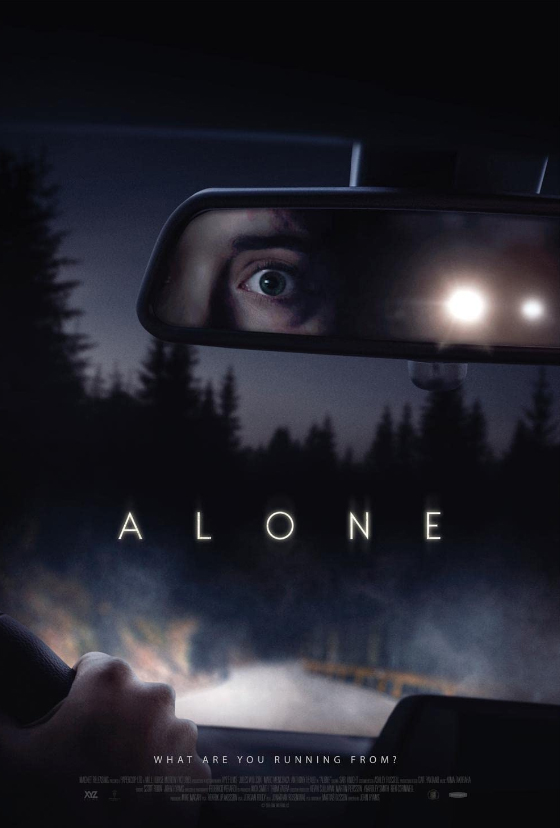
ALONE: A recently widowed traveler is kidnapped by a cold blooded killer, only to escape into the wilderness where she is forced to battle against the elements as her pursuer closes in on her.
Q: In 2020 you scored ALONE for director John Hyams.
Nima Fakhrara: ALONE was an interesting one. That was my first time working with John. We actually have another movie coming out which just premiered at TIFF called SICK, from a story by Kevin Williamson. John was very interesting. I got a call from him and his first suggestion for me was, “I want you to do the score but I don’t want you to do any music!” It was this concept of how do we get sound design to become musical. I was fortunate enough to be able to have a little bit of experience doing that with EXISTS (2014) for Eduardo Sánchez, taking the world of found footage and making it into a musical score within that world. This one was a little bit different – John didn’t want any instruments at all. So the sound designer and I began sharing files back and forth, he would send me atmospheres and I took those atmospheres and made them musical, chipping them up into synthesizers, and things like that, and bringing them back to the world of music. And then there’s these amazingly beautiful shots throughout the film as she’s driving through – it’s basically a driving story and a cat-and-mouse chase situation – and we recorded this awesome smaller ensemble that was nearly on the edge of silence. That gave us a very small, very intimate sound throughout the whole film.
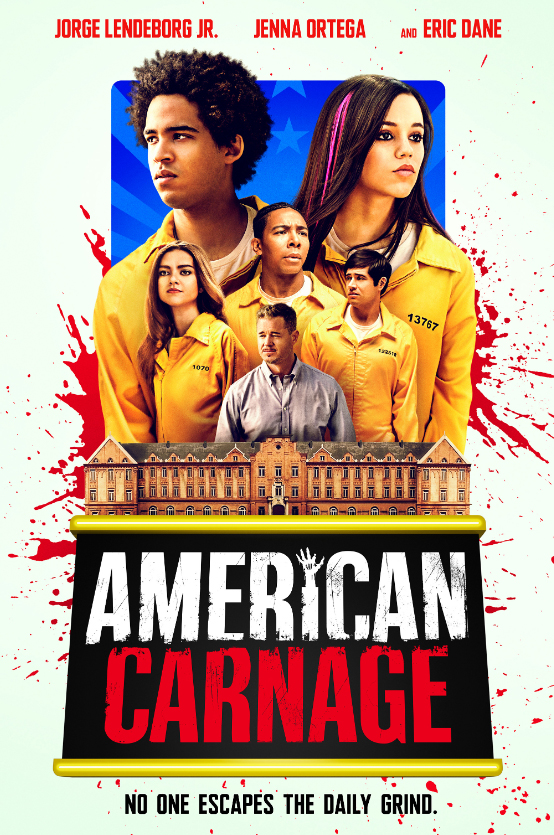
AMERICAN CARNAGE: After a governor issues an executive order to arrest the children of undocumented immigrants, the newly detained youth are offered an opportunity to have their charges dropped by volunteering to provide care to the elderly.
Q: Earlier this year you had a film called AMERICAN CARNAGE, for Diego Hallivis.
Nima Fakhrara: Yes. A lovely film! That’s more of an action comedy thriller, and it was a very fun one to do. I got to work with Mary Ramos, an amazing music supervisor, and it’s a song/score situation on that project. It’s about a group of kids who get arrested wrongfully and things start happening that get weirder and weirder. There’s a political commentary on what’s happening, but in a very facetious manner. Musically speaking, it was very much hip-hop/reggaetone meets big band music. There is a lot of DJ-based techniques that I had to pull out from my high school years, and doing stuff like scratching to records and manipulating a lot with found samples, and also going back and finding things that I did a while ago as far as beats are concerned. And then there’s a big rap ensemble on top of it! It’s a pretty wild score.
SICK: Due to the pandemic, Parker and her best friend decide to quarantine at the family lake house alone – or so they think.
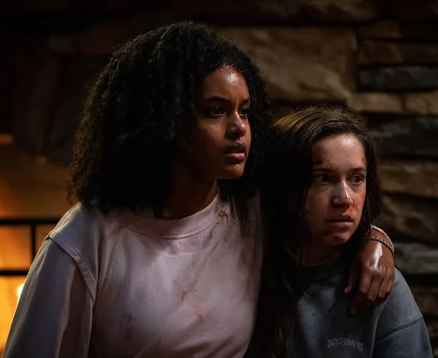
Q: You mentioned SICK, which comes out on October 12th. What can you tell me at this point, without spoiling anything about the story prior to release?
Nima Fakhrara: SICK is writer Kevin Williamson and director John Hyams. They’re both amazing collaborators. This was one of those things that John called me before he shot the film and said, “Let’s start writing! What do you want to write?” It’s another pandemic story about two girls who are going away to isolation for a couple of weeks and bad things start happening to them! I came up with a crazy idea and the first thing my music editor said was, “You know it’s crazy, right?” I basically scored the whole thing with woodwinds! We got a 12-player bass clarinet section together and recorded them for about six or seven hours. This amazing, amazing sound came out of that group! There’s a lot of flutes and a lot of air in it to represent what COVID was at the time and still is. Just the idea of breaths are played a lot, and this was one of those things where I isolated myself, not in the absolute world but musically. It’s a very specific ensemble of just woodwind and woodblocks. The percussion elements were woodblocks or something that had been manipulated from the woodblocks’ world; or the clicking of flutes and the clicking of the actual mechanics of these woodwinds, and that was how the percussion process came about.
Q: You’ve obviously composed a variety of scores over the years, though action and horror films seem to be something you return to – or get called for. What do you most enjoy about these types of films?
Nima Fakhrara: Every one of them is very different. I love the concept of extreme emotions. I love to understand how a character can go from zero to 75 mph, and how quick and fast that can happen. As far as the composer is concerned, I’m always in servitude to the picture itself, so for me it’s always a challenge and always an understanding of how to score a character better and better and better. These extreme emotions come about and you’re able to score then nicely and it works. It’s very rewarding and is very much worthy of kudos to yourself when it happens correctly. That’s what’s beautiful about a lot of these things. They’re crazy characters and most of them are going through a lot of extreme emotion, and that’s the fun part.
Many of the scores we’ve discussed here can be heard or downloaded from Spotify and/or Amazon.
Special thanks to Andrew Krop and Yefan Zhang of White Bear PR for facilitating this interview, and of course to Nima Fakhrara for an engaging discussion on his music.
For more details on the composer, see his website https://nimafilmmusic.com/
See also my interviews with Nima about his latest thriller score, LOU (starring Academy Award winner Allison Janney), in my September 2022 Soundtrax column, and THE GIRL IN THE PHOTOGRAPHS, EXISTS, and other genre scores in my October 2016 Soundtrax.
